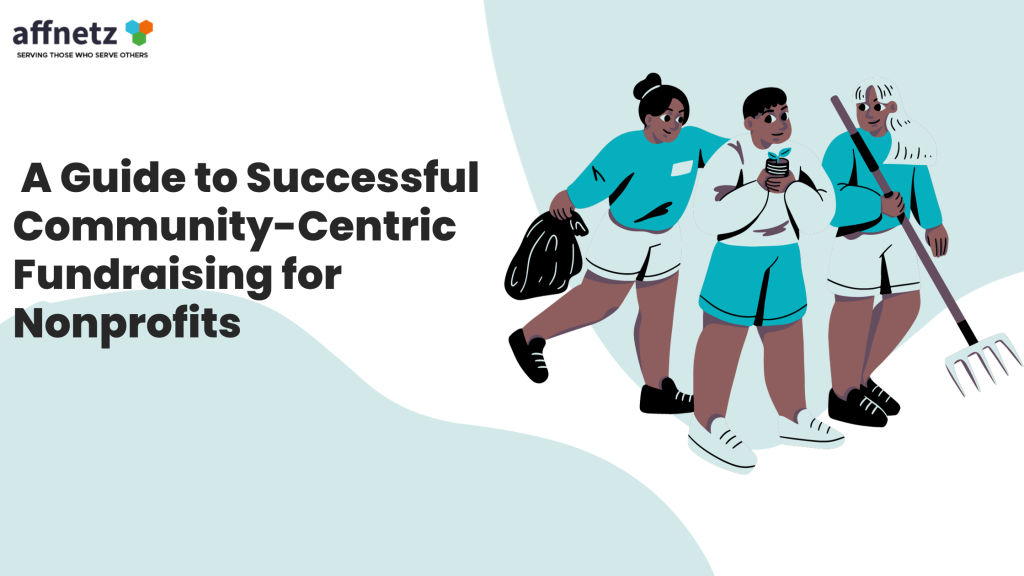Dive into the transformative realm of fundraising as we unravel the profound impact of the 10 Principles of Community-Centric Fundraising. Join us on a journey that reshapes nonprofit dynamics, prioritizes community voices, and sparks a revolution in philanthropy
Community-Centric Fundraising (CCF) is a revolutionary approach that is reshaping how organizations connect with their supporters. It places community at the forefront and is changing the game for nonprofits. But why is this shift so important l, and what’s the historical context of CCF?
Let’s explore the Community-Centric Fundraising model, the 10 principles of community centric fundraising, and understand why it can be a game-changer for your Nonprofit.
What is Community-Centric Fundraising?
Community-Centric Fundraising, is no ordinary concept. It’s a movement that transcends traditional fundraising approaches by focusing on people, not just dollars. Its core objective? Building relationships, valuing community voices, and prioritizing the mission above monetary targets.
In 2015, Vu Le, the writer of the ‘NonprofitAF’ blog, published an article that expressed what the nonprofit world had been experiencing for decades. For example, excessively praising donors and perpetuating the ‘White Savior Complex’ is one example of problematic behaviour. When multiple fundraisers (especially women, and people of color) noticed the disconnect between fundraising principles and mission goals, they knew it was time to make a change. When philanthropy relies on the scraps of generational wealth, something marginalized communities don’t have access to, we perpetuate a system of oppression.
Historically, fundraising was exclusively focused on donors. This meant more resources being spent on media communications and less focus on bringing social justice. With Community-Centric-Fundraising, Nonprofits are empowered to do the work they’re best at – providing valuable services to their communities.
In essence, CCF is like a superhero team, dedicated to creating a more equitable and inclusive world.
10 Principles of Community-Centric Fundraising:

At the heart of CCF are critical principles that guide its actions and impact. Let’s dive into these principles and bring them to life with nonprofit-specific examples:
- Authentic Engagement: CCF encourages nonprofits to engage with their community authentically. This means listening actively, responding genuinely, and involving supporters in decision-making.
For instance, imagine a nonprofit dedicated to promoting racial equity. Instead of just soliciting financial support, they actively engage community members from diverse backgrounds in discussions about how to address systemic racism. This involvement empowers people to share their experiences and insights, making them feel valued and heard.
- Fundraising must be grounded in race, equity, and social justice: Equity is by no means an easy goal to achieve. While conversations may not change systems overnight, they are an important start that donors especially need to be a part of. As uncomfortable as it may seem, involving our donors in discussions about issues in our communities is a “must-do”.
Fundraising must include volunteers and staff that represent the communities we wish to serve. Large corporations must take an active part in community engagement. It doesn’t end here, but these measures are vital to combat the challenges facing each of our communities.
- Transparency: Transparency is a key principle that is concerned with being open and honest with your community. For instance, a children’s education charity might openly share how donations are allocated, providing donors with a clear view of where their money goes. This builds trust and shows your commitment to your mission.
- Shared Leadership: CCF promotes shared leadership, allowing community members to take on leadership roles within the organization. Imagine a health clinic where community members serve on the board of directors, bringing their unique perspectives to decision-making and ensuring that the organization truly serves their needs.
Nonprofits must be mutually supportive of one another. Nonprofits have long suffered from the consequences of intense competition within the sector and must be open to sharing ideas, resources and know-how. . Nonprofits must be each other’s biggest allies, sharing resources, opportunities and at times, even donors.
- Inclusivity: Inclusivity is the key to CCF. It means actively involving people from diverse backgrounds in your fundraising efforts. An arts organization may host events that celebrate and showcase the talents of artists from all walks of life, ensuring inclusivity in their programs and events.
6) Cultural Competence: Recognizing and respecting diverse cultural practices and norms in fundraising approaches. Cultural competence is integral to community-centric fundraising, acknowledging and incorporating the rich diversity of traditions and values within a community, ensuring that fundraising strategies are respectful, inclusive, and culturally sensitive.
7) Empowerment: Focusing on empowering communities to be actively involved in and lead fundraising initiatives that affect them. This principle ensures that fundraising efforts not only support communities but also provide them with the tools and knowledge to drive positive change on their own terms.
8) Accessibility: Making fundraising processes and opportunities accessible to a broad range of community members. By prioritizing accessibility, community-centric fundraising aims to break down barriers, ensuring that everyone, regardless of background or circumstance, has an equal opportunity to participate and contribute to the cause.
9) Listening and Learning: Actively seeking and valuing input from community members to inform and adapt fundraising strategies. This principle emphasizes the importance of an ongoing dialogue with the community, fostering a dynamic relationship where fundraisers listen, learn, and evolve their approaches based on the unique insights and needs expressed by those they aim to serve.
10) Accountability:Holding fundraisers accountable for their actions and the impact of their initiatives on the community. Upholding accountability ensures transparency and ethical conduct in fundraising practices, reinforcing the trust between fundraisers and the community. It also encourages continuous improvement, as fundraisers take responsibility for the consequences of their efforts and strive to maximize positive outcomes for the community.
Why Community Centric Fundraising Matters
Intention and impact don’t always go hand-in-hand. The 10 principles of community centric fundraising is an effort to bridge this gap. Although Nonprofits intend to do what’s best for the community, the current philanthropy model does not support equitable growth of our communities; the result of which has been borne heavily by marginalized communities.
The CCF approach bridges the gaps that traditional fundraising methods have struggled to address.. CCF can provide answers to pressing issues that the nonprofit sector has been grappling with for decades.
By emphasizing community, CCF fills the gaps left by transactional fundraising. It’s not just about collecting donations; it’s about nurturing relationships, building trust, and sharing a collective vision. CCF is the tool we need to combat issues like donor fatigue, lack of diversity, and distrust in nonprofits.
Community-Centric Fundraising matters because fundraising practices have often been directed towards creating a feel-good experience for wealthy donors . Nonprofits often try to fulfill every donor’s ‘do-good’ quota, all while making it seamless and uncomplicated. This model can be dangerous and regressive.
Philanthropy is rarely uncomplicated, and social justice cannot be achieved by a check- no matter how big. This is where Community-Centric Fundraising aims to make a difference, by finally giving the power back to the people who need it the most.
How to Implement Community-Centric Fundraising
Implementing CCF isn’t a mere adjustment; it’s a cultural shift. The 10 principles of community centric fundraising is a great place to start. To become a CCF champion, nonprofits should:
- Embrace a Community-First Mindset: Shift your focus from money to people. Make your community the center of your universe.
- Involve Community Leaders: Invite community members to lead and be part of your decision-making processes.
- Prioritize Communication: Keep your supporters informed, engage in open dialogue, and actively listen to their needs and ideas.
- Foster Inclusivity: Make diversity a cornerstone of your efforts, ensuring everyone feels welcome and valued.
- Stay Committed: CCF is a long-term commitment. It’s not about quick wins, but building lasting, meaningful relationships.
Peer-to-peer fundraising is one way to include your community in your philanthropic efforts. Peer-to-peer fundraising software can often be complex and expensive, but with Affnetz you get all our solutions at one price. Take advantage of Affnetz’s innovative Peer-to-peer fundraising software and many other offerings. Affnetz provides an all-in-one Nonprofit fundraising software solution that is intuitive, integrated and just what your Nonprofit needs.
It helps to examine your nonprofit culture:
- Does your staff feel comfortable and welcome in the workplace?
- How do you exercise inclusivity with your staff?
- Do you hire people from marginalized communities?
- What does your pay parity look like?
Getting the answers to these questions and more might help you evaluate how Community-Centric your Nonprofit is.
Encourage open dialogue in the workplace. Ask your staff, either anonymously or in public, how they feel at the workplace. These discussions might not always be fruitful after the first try, but with time, a shift to your Nonprofit’s culture to be more transparent can be worth the effort.
In the grand finale, let’s remember the power of community building. Highlighting the stories of fundraisers, especially those from marginalized backgrounds, is crucial. Their struggles are woven into the tapestry of the CCF movement, making it more inclusive and dynamic. The 10 principles of community centric fundraising are a general framework to guide Nonprofits through this much-needed journey.
Affnetz is committed to helping Nonprofits prioritize their communities, by allowing Nonprofits to truly engage all stakeholders, not just donors. We understand the importance of hearing from your communities and Affnetz helps you do exactly that…communicate efficiently at a capacity that suits your Nonprofit.
Investing in Nonprofit fundraising software doesn’t have to be complicated. Affnetz provides a free trial of up to 1 year!
Want to learn more? Contact us at [email protected] or fill out the Contact Us form and we’ll get back to you!
As we conclude, imagine a world where nonprofits and communities unite like a league of justice, working together for a common cause. CCF is our hero, paving the way for a brighter future where nonprofits and communities are true partners, working to create a better, more equitable world. It’s a mission worth embarking on, and it’s time for all of us to join the CCF movement.




